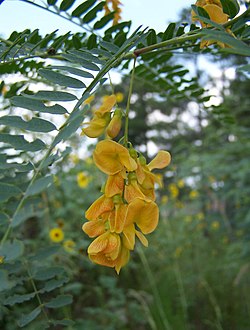| Sesbania | |
|---|---|
 | |
| Sesbania drummondii | |
| Scientific classification | |
| Kingdom: | Plantae |
| Clade: | Tracheophytes |
| Clade: | Angiosperms |
| Clade: | Eudicots |
| Clade: | Rosids |
| Order: | Fabales |
| Family: | Fabaceae |
| Subfamily: | Faboideae |
| Clade: | Meso-Papilionoideae |
| Clade: | Non-protein amino acid-accumulating clade |
| Clade: | Hologalegina |
| Clade: | Robinioids |
| Tribe: | Sesbanieae Hutch. |
| Genus: | Sesbania Adans. (1763), nom. & orth. cons. |
| Species [1] | |
60; see text | |
| Synonyms [1] | |
| |

Sesbania is a genus of flowering plants in the pea family, Fabaceae, and the only genus found in tribe Sesbanieae. Riverhemp is a common name for plants in this genus. [2] Notable species include the rattlebox ( Sesbania punicea ), spiny sesbania ( Sesbania bispinosa ), and Sesbania sesban , which is used in cooking. Plants of this genus, some of which are aquatic, can be used in alley cropping to increase the soil's nitrogen content. The species of rhizobia responsible for nitrogen fixation in Sesbania rostrata is Azorhizobium caulinodans .
Contents
- Fossil record
- List of species
- Section Glottidium (Desvaux) Lavin
- Section Daubentonia (DC.) Bentham
- Section Sesbania Adans.
- Incertae Sedis
- Phylogeny
- References
- External links
Some 60 species are currently accepted, with about 39 still unresolved. The genus is native to tropical and subtropical regions around the world, in the Americas from the southern United States to northern Argentina, in sub-Saharan Africa, in southern Asia, and in New Guinea, Australia, and the Pacific. [1] The largest number of species are found in Africa, and the remainder in Australia, Hawaii, and Asia. [3]